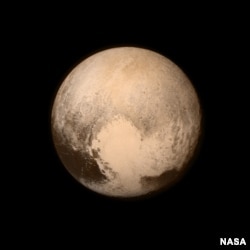ອົງການອະວະກາດສະຫະລັດ ຫຼື NASA ໄດ້ນຳສະເໜີ
ຮູບພາບຈຳນວນໜຶ່ງ ຂອງດາວພະຍົມ ຫຼື Pluto ທີ່ຖ່າຍ
ມາຈາກຍານອະວະກາດ New Horizons ໃນຂະນະທີ່
ມັນບິນຜ່ານ ດາວນ້ອຍດວງນີ້ ເມື່ອວັນອັງຄານ ທີ 14
ກໍລະກົດ. ຍານອະວາກາດດັ່ງກ່າວໃຊ້ເວລາກະກຽມໜຶ່ງ
ທົດສະວັດ ເພື່ອການເດີນທາງໄລຍະ 4.8 ຕື້ກິໂລແມັດ
ຜ່ານລະບົບສຸລິຍະຈັກກະວານຂອງພວກເຮົາ ເພື່ອທີ່ຈະ
ບິນເຂົ້າໃກ້ ດາວພະຍົມໃຫ້ຫຼາຍທີ່ສຸດ ເທົ່າທີ່ເປັນໄປໄດ້
ແບບບໍ່ເຄີຍມີມາກ່ອນ. ຜູ້ສື່ຂ່າວວີໂອເອ Zlatica Hoke
ລາຍງານວ່າ ພາບຖ່າຍຕ່າງໆທີ່ ມີຄວາມຊັດແຈ້ງສູງເປັນ
ປະຫວັດການນັ້ນ ຈະຊ່ວຍບັນດານັກວິທະຍາ ສາດຮຽນຮູ້
ຫຼາຍຂຶ້ນ ກ່ຽວກັບວ່າ ລະບົບສຸລິຍະຈັກກະວານ ກໍ່ຕົວຂຶ້ນມາໄດ້ແນວໃດ ແລະ ອາດເປັນ
ໄປໄດ້ ທີ່ຈະຮຽນຮູ້ເຖິງການວິວັດທະນາ ການຂອງສິ່ງທີ່ມີຊີວິດໃນໂລກ. ໄຊຈະເລີນສຸກ
ຈະນຳເອົາເລື້ອງທີ່ໜ້າ ສົນໃຈນີ້ ມາສະເໜີທ່ານ ໃນອັນດັບຕໍ່ໄປ.
ໃນຂະນະທີ່ຍານສຳຫລວດ New Horizons ບິນຜ່ານກາຍ ດາວພະຍົມ ດ້ວຍຄວາມ ໄວເກືອບ 50,000 ກິໂລແມັດຕໍ່ຊົ່ວໂມງ ກ້ອງຖ່າຍພາບ ໄດ້ຖ່າຍເອົາພາບຕ່າງໆ
ຂອງດາວພະຍົມ ໃນໄລ ຍະໃກ້ຊິດ. ບັນດານັກວິທະຍາສາດຂອງອົງການ NASA ກ່າວ
ວ່າ ພາບຕ່າງໆເຫຼົານັ້ນ ສະໜອງຂໍ້ມູນ ທີ່ພວກເຂົາເຈົ້າບໍ່ເຄີຍມີມາກ່ອນ ກ່ຽວກັບຂອບ ນອກສຸດຂອງລະບົບສຸລິຍະຈັກກະວານ.
ທ່ານ John Spencer ນັກທໍລະນີວິທະຍາ ແລະທໍລະນີຟີສິກຂອງໂຄງການ New Horizons ກ່າວວ່າ “ພວກເຮົາໄດ້ພົບເຫັນວ່າ ຢ່າງນ້ອຍ ສ່ວນໜຶ່ງຂອງດາວພະຍົມ ແມ່ນຍັງເຍົາໄວຢູ່. ດາວພະຍົມ ບໍ່ມີຂຸມທີ່ເກີດຈາກສະເກັດດາວຕົກໃສ່ເລີຍ ທີ່ທ່ານ ຄາດຄິດໄວ້ວ່າ ຄວນຈະມີຢູ່ພື້ນຜິວຂອງດາວ ທີ່ມີອາຍຸຫຼາຍແລ້ວ. ສະນັ້ນດາວພະຍົມ ແມ່ນກຳລັງມີການເຄື່ອນໄຫວ ຢູ່ພາຍໃນຂອງມັນ ທີ່ພາໃຫ້ເກີດ
ພື້ນຜິວຈາກ ຂັ້ນຕອນຕ່າງໆ ທີ່ພວກເຮົາຍັງບໍ່ເຂົ້າໃຈເທື່ອ.”
ຍານອະວະກາດລຳນີ້ ໄດ້ສົ່ງຮູບພາບຕ່າງໆ ຂອງດາວພະຍົມ ທີ່ໜ້າ ຕື່ນເຕັ້ນທີ່ສຸດ ກ່ອນ
ໜ້າການບິນຜ່ານ ໃນວັນອັງຄານທີ 14 ກໍລະກົດ ດ້ວຍຊ້ຳ. ພວກຮູບພາບທີ່ຖ່າຍໃນໄລຍະ ໃກ້ນັ້ນ ໄດ້ພາໃຫ້ມີການເພັ່ງເລັງໃສ່ບໍລິເວນຕ່າງໆຊຶ່ງໃນເມື່ອກ່ອນ ຍັງບໍ່ຈະແຈ້ງ ເຊັ່ນບ່ອນທີ່ເອີ້ນວ່າ ໃຈກາງຂອງດາວນັ້ນ.
ບັນດານັກວິທະຍາສາດ ຂອງອົງການ NASA ກ່າວວ່າ ພາບພູມປະ ເທດທີ່ເປັນພູຜາ ແລະ ນ້ຳ ຂອງດາວພະຍົມ ບໍ່ແມ່ນໃນອັນທີ່ພວກເຂົາເຈົ້າ ຄາດຄິດທີ່ຈະເຫັນ.
ທ່ານ ນາງ Cathy Olkin ນັກວິທະຍາສາດ ຮອງຜູ້ອຳນວຍການໂຄງການ New Horizons ເວົ້າວ່າ “ສະນັ້ນ ພວກພູຜາເຫຼົ່ານີ້ແມ່ນກຳລັງສູງຂຶ້ນ ຈາກແຜ່ນພື້ນຜິວທີ່ຂ້ອນຂ້າງລຽບ ຊຶ່ງໃນນັ້ນເອງກໍເປັນທີ່ໜ້າປະລາດໃຈຄືກັນ ຍ້ອນວ່າ ພວກເຮົາໄດ້ຄາດຄິດກັນວ່າ ຈະມີພວກຂຸມທີ່ເກີດຈາກສະເກັດດາວຕົກໃສ່ ໃນບໍລິເວນສ່ວນນັ້ນຫຼື ໃນທົ່ວທຸກແຫ່ງຂອງດາວດັ່ງກ່າວ. ແລະ ດ້ວຍພູຜາທີ່ກຳລັງສູງຂຶ້ນ ເຖິງປະ ມານ 3400 ແມັດ ອັນນີ້ເປັນຕາງຶດຫຼາຍ.”
ບັນດານັກວິທິຍາສາດ ກ່າວວ່າ ມັນຈະໃຊ້ເວລາຫຼາຍກວ່າປີໜຶ່ງ ເພື່ອທີ່ຈະສຶກສາຄົ້ນຄວ້າ
ພາບເຫຼົ່ານັ້ນ. ແຕ່ອັນທີ່ພວກເຂົາເຈົ້າ ໄດ້ເຫັນໃນສອງສາມຊົ່ວໂມງ ເປັນຄັ້ງທຳອິດແມ່ນໄດ້ ປ່ຽນ ທັດສະນະຄະຕິໃນເມື່ອກ່ອນ ກ່ຽວກັບດາວພະຍົມ.
The U.S. space agency, NASA, has presented some of the images of Pluto taken from a spacecraft as it passed by the dwarf planet on Tuesday. New Horizons took a decade to make the 3 billion-mile journey through our solar system to make the closest approach ever to Pluto.Zlatica Hoke reports that the historic high-resolution photographs will help scientists learn more about how the solar system was formed and possibly about the development of life on Earth.
The close-up photos of Pluto were taken as New Horizons flew by at a speed of nearly 50,000 kilometers per hour. NASA scientists say the images provide information they previously did not have about the outer edge of our solar system.
(JOHN SPENCER, GEOLOGY AND GEOPHYSICS, NEW HORIZONS MISSION)
"We have found that at least parts of Pluto are very young. They don't have any craters that you would expect on an old surface. So Pluto is active on the interior - it is generating landscapes by processes we don't understand yet."
The spacecraft sent one of the most exciting images of Pluto even before the fly-by Tuesday. The close-up photos bring to focus once blurry areas, such as the one called the planet's heart.
NASA scientists say Pluto's topography of mountains and water was not what they expected.
(CATHY OLKIN, DEPUTY PROJECT SCIENTIST, NEW HORIZONS MISSION)
"So these mountains are rising out of the relatively smooth terrain, which in and of itself is surprising also, because we would have thought there'd be more craters on that part, or across the whole thing. And with the mountains ((that)) are rising up to heights about 11,000 feet ((3,400 meters)), this is just astounding."
Scientists say it is going to take them more than a year to research the images.But what they have seen in just the first few hours has changed previous conceptions about Pluto.
The New Horizons team is thrilled that the spacecraft did not suffer any damaging crashes with moons around Pluto. The close-up images of the largest one, Charon, also provide surprising information.
(ALAN STERN, PRINCIPAL INVESTIGATOR, NEW HORIZONS MISSION)
"We look at Charon and we find - oh, the thing does not have enough craters on it. It must be active.It must have in the recent past.... this tiny little world, just the size of Texas, has canyons longer than the Grand Canyon on it, created by tectonics."
The United States is the first nation to reach Pluto. With this latest space mission, it has visited every planet in our solar system.












